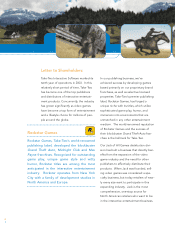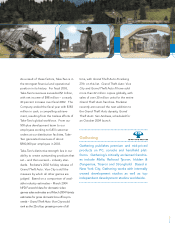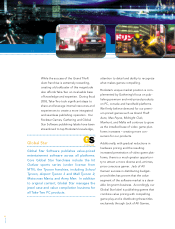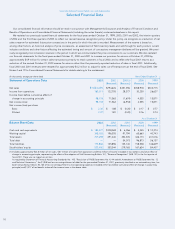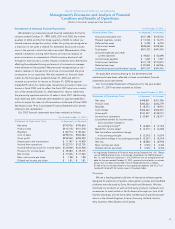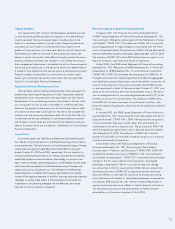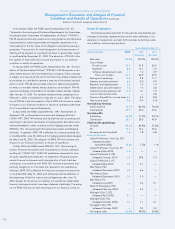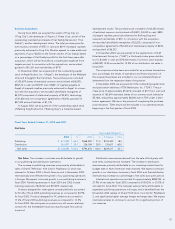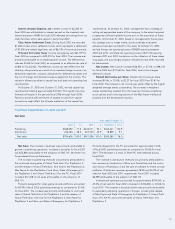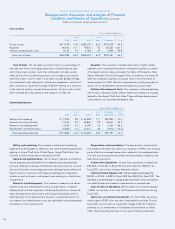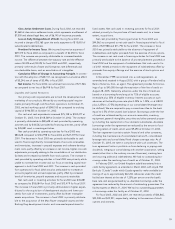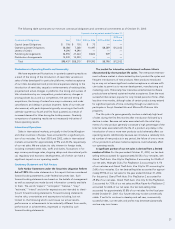2K Sports 2003 Annual Report Download - page 14
Download and view the complete annual report
Please find page 14 of the 2003 2K Sports annual report below. You can navigate through the pages in the report by either clicking on the pages listed below, or by using the keyword search tool below to find specific information within the annual report.
Our principal sources of revenue are derived from publishing and
distribution operations. Publishing revenues are derived from the sale
of internally developed software titles or software titles licensed from
third parties. Operating margins in our publishing business are
dependent upon our ability to continually release new, commercially
successful products. We develop most of our front-line products inter-
nally, and we own all of our major intellectual properties, which we
believe permits us to maximize profitability.
Our distribution revenues are derived from the sale of third-party
software titles, accessories and hardware. Operating margins in our
distribution business are dependent on the mix of software and hard-
ware sales, with software generating higher margins than hardware.
Publishing activities generate significantly higher margins than distribu-
tion activities, with sales of PC software titles resulting in higher margins
than sales of products designed for video game consoles.
We have pursued a growth strategy by capitalizing on the wide-
spread market acceptance of video game consoles and the growing
popularity of innovative gaming experiences that appeal to more
mature audiences. We have established a portfolio of successful pro-
prietary software content, including our premier brands: Grand Theft
Auto, Max Payne and Midnight Club, for the major hardware plat-
forms. We expect to continue to be the leader in the mature, action
product category by leveraging our existing franchises and develop-
ing new brands, such as Manhunt.
We currently anticipate that the release of new brands in fiscal
2004, including The Warriors and Red Dead Revolver, along with the
launch of the next installment of Grand Theft Auto, will generate sig-
nificant cash flow from our publishing business. We also believe that
we will be able to continue to grow our distribution business through
a combination of our retail relationships and our value product offer-
ings.
Historically, each generation of video game consoles and hand-
held platforms experiences a gradual decrease in retail pricing over
the life of the system, with retail pricing for software titles following
a similar trend. The PlayStation 2 and Xbox were introduced several
years ago, and have been reduced in price since their launch, with
additional price reductions anticipated to occur in 2004. Reduced
pricing for our titles could result in lower margins for our published
products and reduced growth rates in our publishing business.
However, as retail prices for interactive entertainment hardware and
software decline, our distribution business benefits from the wider
availability of higher margin, value priced software titles.
Estimates
The preparation of financial statements in conformity with general-
ly accepted accounting principles requires management to make esti-
mates and assumptions that affect the reported amounts of assets
and liabilities and the disclosure of contingent assets and liabilities at
the dates of the financial statements and the reported amounts of net
sales and expenses during the reporting periods. The most significant
estimates and assumptions relate to the recoverability of prepaid roy-
alties, capitalized software development costs and other intangibles,
inventories, realization of deferred income taxes and the adequacy
of allowances for returns, price concessions and doubtful accounts.
Actual amounts could differ significantly from these estimates.
Revenue Recognition
We recognize revenue upon the transfer of title and risk of loss to
our customers. We apply the provisions of Statement of Position 97-2,
“Software Revenue Recognition” in conjunction with the applicable
provisions of Staff Accounting Bulletin No. 101, “Revenue Recogni-
tion.” Accordingly, we recognize revenue for software when (1) there
is persuasive evidence that an arrangement with our customer exists,
which is generally a customer purchase order, (2) the software is deliv-
ered, (3) the selling price is fixed or determinable and (4) collection of
the customer receivable is deemed probable. Our payment arrange-
ments with customers typically provide net 30- and 60-day terms.
Revenue is recognized after deducting estimated reserves for
returns and price concessions. In specific circumstances when we do
not have a reliable basis to estimate returns and price concessions or
are unable to determine that collection of receivables is probable, we
defer the sale until such time as we can reliably estimate any related
returns and allowances and determine that collection of the receiv-
ables is probable.
Allowances for Returns and Price Concessions
We accept returns and grant price concessions in connection with
our publishing arrangements. Following reductions in the price of
our products, we grant price concessions to permit customers to take
credits against amounts they owe us with respect to merchandise
unsold by them. Our customers must satisfy certain conditions to
entitle them to return products or receive price concessions, including
compliance with applicable payment terms and confirmation of field
inventory levels.
Our distribution arrangements with customers do not give them
the right to return titles or to cancel firm orders. However, we some-
times accept returns from our distribution customers for stock balanc-
ing and make accommodations to customers, which include credits
and returns, when demand for specific titles falls below expectations.
We make estimates of future product returns and price conces-
sions related to current period product revenue. We estimate the
amount of future returns and price concessions for published titles
based upon, among other factors, historical experience, customer
inventory levels, analysis of sell-through rates and changes in demand
and acceptance of our products by consumers.
Significant management judgments and estimates must be made
and used in connection with establishing the allowance for returns
and price concessions in any accounting period. We believe we can
make reliable estimates of returns and price concessions. However,
actual results may differ from initial estimates as a result of changes in
circumstances, market conditions and assumptions. Adjustments to
estimates are recorded in the period in which they become known.
TAKE-TWO INTERACTIVE SOFTWARE, INC. AND SUBSIDIARIES
Management’s Discussion and Analysis of Financial
Condition and Results of Operations (continued)
(Dollars in thousands, except per share amounts)
12


